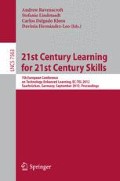Abstract
We present a research on students’ learning styles and their learning activity with respect to multimedia learning resources in a virtual learning environment within a Moodle online course. We investigate the relation between learning styles based on sensory modality and their learning activity regarding different types of multimedia resources.
VARK is a sensory model developed by Neil Fleming. It is an acronym for Visual (V), Aural (A), Read/Write (R), and Kinesthetic (K).
Considering the VARK questionnaire results, we came to a conclusion that two out of three students have multimodal learning styles and prefer combining different types of resources. The most used type of resource is pictorial accompanied by text (72%). Considering log file data analysis it is shown that students with higher visual learning style scores obtained by the VARK questionnaire have lower tendency of accessing pictorial resources accompanied by text. Furthermore, at the end of each lesson we conducted a survey allowing multiple answers asking students what type of resources they have been using.
Results show that the usage of video resources is highly correlated with the access to the same resources. Correspondingly the usage of textual resources is highly correlated with the access to the same resources. Moreover, a negative correlation exists between the usage of pictorial resources and the access to textual resources, meaning that the students who preferred pictorial resources accompanied by text, accessed to textual resources less.
However, the usage of pictorial resources accompanied by text has low correlation with the access to those resources. Considering this fact, it could be possible that students spent more time studying the pictorial resources accompanied by text, therefore accessing those resources less.
Access this chapter
Tax calculation will be finalised at checkout
Purchases are for personal use only
Author information
Authors and Affiliations
Editor information
Editors and Affiliations
Rights and permissions
Copyright information
© 2012 Springer-Verlag Berlin Heidelberg
About this paper
Cite this paper
Lauc, T., Kišiček, S., Bago, P. (2012). Students’ Usage and Access to Multimedia Learning Resources in an Online Course with Respect to Individual Learning Styles as Identified by the VARK Model. In: Ravenscroft, A., Lindstaedt, S., Kloos, C.D., Hernández-Leo, D. (eds) 21st Century Learning for 21st Century Skills. EC-TEL 2012. Lecture Notes in Computer Science, vol 7563. Springer, Berlin, Heidelberg. https://doi.org/10.1007/978-3-642-33263-0_64
Download citation
DOI: https://doi.org/10.1007/978-3-642-33263-0_64
Publisher Name: Springer, Berlin, Heidelberg
Print ISBN: 978-3-642-33262-3
Online ISBN: 978-3-642-33263-0
eBook Packages: Computer ScienceComputer Science (R0)

